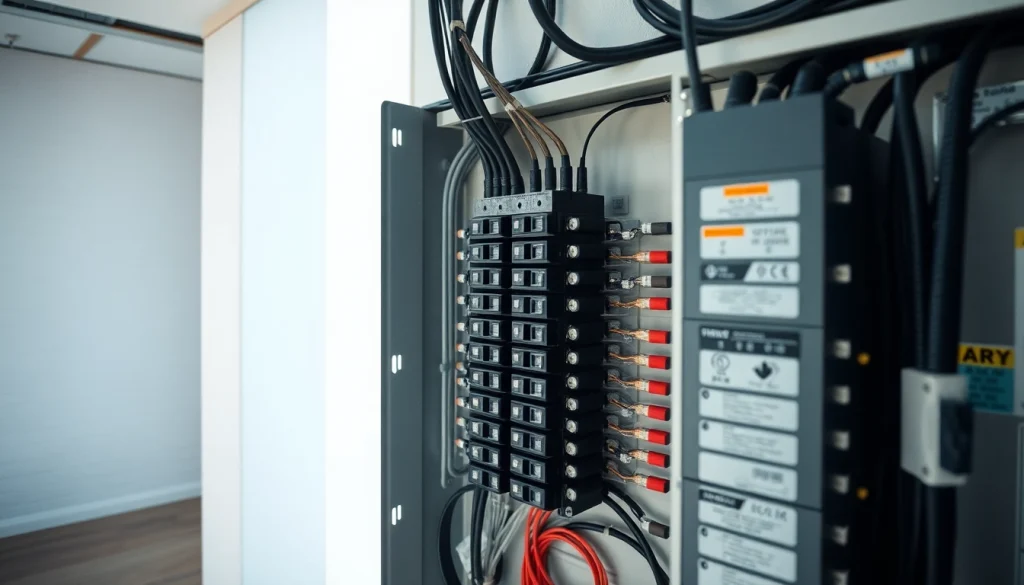Understanding When to Upgrade Your Electrical Panel: Key Signs and Solutions

What is an Electrical Panel? Understanding the Basics
Definition and Purpose of Electrical Panels
An electrical panel, often referred to as a breaker box or service panel, is a crucial component in any electrical system. It acts as the central hub for distributing electricity throughout a home or commercial building. By controlling the flow of electrical power to various circuits, an electrical panel ensures that every connected device receives the appropriate voltage and current necessary for its operation.
The purpose of the electrical panel is twofold: first, it delivers power from the main service line to individual electrical circuits, and second, it serves as a protective measure to prevent overloads. In essence, the electrical panel is the heart of your electrical system, ensuring that your living or working space is energized safely and efficiently. Understanding when to upgrade this essential component is vital for maintaining a functional and safe electrical system. For further insights, refer to this detailed resource on Electrical Panel.
Components of an Electrical Panel
An electrical panel encompasses several critical components, each serving distinct roles in preserving electrical safety and functionality. Key elements include:
- Main Breaker: This circuit breaker controls the power supply from the utility company and can be turned off in case of an emergency.
- Circuit Breakers: These are switches that automatically cut off electrical flow to a circuit in the event of an overload or short circuit.
- Bus Bars: Conductive strips that distribute power to multiple circuit breakers.
- Grounding and Bonding Conductors: These ensure safety by directing electrical surges away from wires and into the ground.
- Enclosure: The outer covering that houses the components, providing protection and security.
Common Terminology Explained
To better understand how electrical panels function, it’s essential to familiarize yourself with some key terms:
- Amperage: The measure of electrical current. Most residential panels range from 100 to 200 amps.
- Voltage: The electrical potential difference provided by your utility service, usually 120/240 volts in residential settings.
- Load: The total amount of electrical power consumed by connected devices.
- Subpanel: A smaller panel that distributes power to a specific area of a building, relieving the main panel of some workload.
Signs You Need to Upgrade Your Electrical Panel
Frequent Circuit Breaker Trips
One of the primary indicators that your electrical panel may need an upgrade is the frequent tripping of circuit breakers. If you find yourself resetting breakers regularly, it could signify that your panel is overloaded, unable to handle the demands of your current electrical needs. Continuous tripping may lead to further safety concerns, including the risk of electrical fires, so addressing this issue promptly is essential.
Overloading and Electrical Demand
As households accumulate more electronic devices and appliances, the demand for electrical power increases. If your home has undergone significant renovations or if your family size has grown, an electrical panel that was adequate before may no longer suffice. Increasing the number of high-amperage devices such as refrigerators, air conditioners, or electric clothes dryers puts undue stress on an older panel, potentially leading to performance issues and safety risks.
Age of Your Current Electrical Panel
The age of your electrical panel itself can indicate when an upgrade is necessary. Many residential panels last between 25 and 40 years, depending on usage and maintenance. If your panel is outdated, it may lack the modern safety features required to handle contemporary electrical loads efficiently. Additionally, older panels may not comply with current electrical codes, which can be a significant concern for homeowners wanting to ensure the safety of their property.
Types of Electrical Panels and Their Functions
Service Panels Versus Subpanels
Electrical panels typically fall into two categories: service panels and subpanels. A service panel, often referred to as the main panel, is your primary method of distributing electricity from the utility company. Conversely, subpanels are additional panels connected to the main panel, used to manage power distribution to specific areas or circuits—ideal for garages, workshops, or areas with higher electrical needs. Understanding the distinction between these two types can help homeowners choose the right configuration for their needs.
Understanding Circuit Breakers
Circuit breakers are the unsung heroes of electrical systems. Their primary role is to interrupt current flow during overload conditions, protecting circuits from damage. They come in various types, including standard circuit breakers, GFCI (Ground Fault Circuit Interrupter) breakers for wet areas, and AFCI (Arc Fault Circuit Interrupter) breakers designed to prevent electrical fires. Identifying which circuit breakers are suitable for your home and whether upgrades are necessary is crucial for both safety and efficiency.
Comparing Standard and Smart Electrical Panels
Traditional electrical panels are generally straightforward in function. However, emerging technology has introduced smart electrical panels, which enhance functionality and safety. Smart panels include advanced features such as real-time monitoring of electricity usage, systematic overload protection, and remote management capabilities through mobile applications. These panels can help homeowners make better energy decisions, thus saving money, while offering superior protection against electrical issues.
The Upgrade Process: What to Expect
Consulting with a Licensed Electrician
Before making any decisions about upgrading your electrical panel, it’s imperative to consult with a licensed electrician. They can assess your current system, evaluate your electrical load needs, and determine whether your existing panel meets safety standards and local building codes. This professional assessment ensures that your upgrade is appropriate for your specific circumstances.
Factors Influencing Upgrade Costs
The cost of upgrading an electrical panel can vary based on several factors, including:
- Panel Size: Larger panels generally cost more due to increased capacity and complexity.
- Material Costs: The choice of materials, such as copper versus aluminum wiring, can significantly affect overall expenses.
- Labor Costs: The price of labor varies by region and the complexity of the installation process.
- Permits and Inspections: Costs associated with obtaining the necessary permits and inspections can also add to the overall cost of an upgrade.
Installation Timeline and Preparation
Upgrading your electrical panel typically requires several hours to a full day, depending on the complexity of the installation and whether additional upgrades or repairs are needed. Homeowners should prepare by clearing the area around the electrical panel and ensuring that access is unobstructed. Additionally, coordinating with your electrician on the timing will help ensure a smooth process.
Maintaining Your Electrical Panel: Best Practices
Regular Inspections and Maintenance
Maintaining an electrical panel is crucial for ensuring safety and functionality over time. Regular visual inspections can help identify potential problems before they escalate. Homeowners should look for signs of wear such as discoloration, unusual noises, or the smell of burning plastic. It’s advisable to schedule a professional inspection at least every few years, or sooner if any issues arise.
Signs of Wear and Tear
Recognizing the signs of wear and tear on your electrical panel can prevent critical failures or safety hazards. Look for:
- Brittle or frayed wires
- Loose connections
- Burn marks or discoloration on the panel
- Frequent circuit breaker trips
Upgrading Safety Features Over Time
Technological advancements have led to more effective safety features being developed for electrical panels. As new innovations occur, consider upgrading your panel to include GFCI or AFCI breakers if they aren’t already part of your setup. Additionally, integrating smart technology can provide real-time monitoring and alert systems, significantly enhancing the safety and efficiency of your electrical system.







